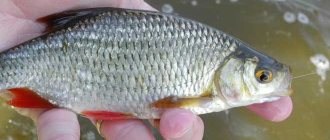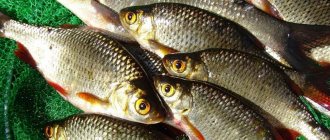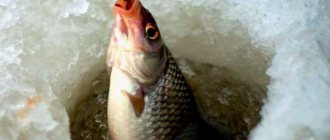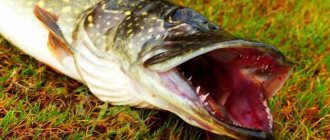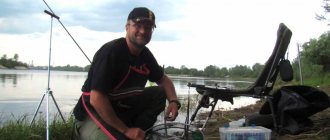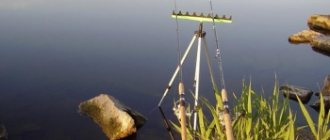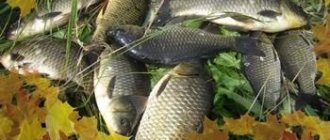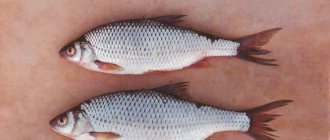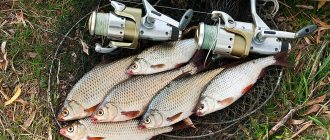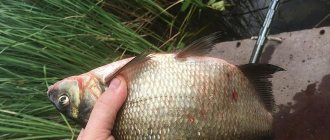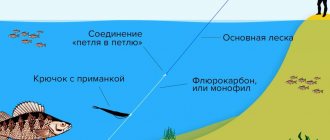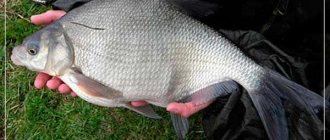Fishermen use a variety of rods, lures, groundbaits and baits in their fishing equipment. Catching roach with a float rod is the fastest and most effective fishing method. With this rod you can catch both large and small roach. At the same time, due to the fairly simple design of the fishing rod and the fishing method itself, any fisherman can catch roach on a float, and the result can be better than when using feeders. All you have to do is choose the right lure and bait.
Fishing for roach begins in early spring and ends with a sharp cold snap, snowfall or cover of the reservoir with ice. The fish begins active feeding around mid-April, when the water is just starting to warm up. The fish need to gain strength in order to go to spawn, which it will begin with warming. When the water temperature reaches +10o, the roach and other individuals will go to spawn and will not respond to complementary feeding. Therefore, it is important to go fishing at a time when it is not in a state of spawning.
Peculiarities of roach behavior
Any fish reacts to the slightest changes in the weather, so it is important to monitor the temperature and atmospheric pressure for several days before going fishing. You also need to understand some behavioral features, for example, in the heat, the fish hides at depth, that is, it moves further from the shore, into holes.
To choose the most favorable day for biting rams, you need to pay attention to changes in temperature and atmospheric pressure during the current. there shouldn't be any for a few days
Appearance
Usually they choose a not hot day, when there is either sun or clouds in the sky and a slight breeze blows slightly on the pond. The bite begins at sunrise and lasts until about 9 am in still cool water, and then the evening period begins from 6 am until sunset. Ram does not like the summer heat, so it is mostly caught on cool days.
Catching roach with a float should be carried out taking into account the preferences and behavior of the fish during a certain period in a certain body of water.
Roach in spring
Behavioral patterns are also reflected in the seasons. After the ice on a river or lake melts, the fish begin their activity. As the weather warms up, it begins to actively peck at various baits. She feeds on literally everything she comes across. Begins active feeding before spawning and after laying eggs.
Spring specimen
The beginning of spawning depends on how early the warm spring arrives in the region. It can begin in March (southern regions) or in May. It moves in flocks and eats everything it sees during the period of active feeding.
In spring it often bites on bloodworms, maggots, worms and caddis flies.
In summer
With the beginning of summer, it increasingly approaches the shore in search of food. As soon as active growth of grass and insects begins, the roach switches to this food and hunts for it. At the same time, it does not like bright sun and intense heat, so in hot weather you can only catch it in the morning or at night. In the summer, it actively reacts to various baits that imitate living creatures, approaches the food and bites well.
Animals also use bait - maggots, worms, dragonfly larvae, shell meat.
in autumn
The colder the water becomes, the further the roach moves from the shore. She switches to food, which is located at the bottom of the reservoir, thereby preparing for wintering under a layer of ice. In autumn it bites only on animal bait. In September it can behave the same way as in summer, but closer to frost it becomes picky and reacts poorly to baits, groundbaits, flavors and dyes.
It is better to use worms, maggots, and bloodworms as bait.
How to fish in the winter while skating
- Everyone's favorite bloodworm is considered the main bait for stream fishing. You can also try maggot, a common worm. To give the rig additional buoyancy, you can install a small foam ball on the baited hook.
- After throwing the tackle into the hole, and when the sinker falls to the bottom, the tackle begins to rise with a slow and smooth movement with a barely noticeable swaying of the nod. The method is reminiscent of fishing with a jig, only the vibration frequency is much lower. If there are no bites during these minutes, the tackle returns to the hole again.
- With each cast, the current will carry away the gear. To “beat the bottom”, you need to unwind a little fishing line from the reel each time. Considering this point, it is possible to ensure the free rotation of the reel drum in advance.
- If a school of fish has chosen a place at shallow depths, then the fishing gear has to be slightly altered.
- To increase the sail of the tackle, thicker fishing line is used, and sinkers are selected with less weight.
- Upstream, a few meters (at least 5 m) from the discovered parking lot, a hole is drilled, the gear is cast, and the bait is delivered closer to the “fishing” place.
The main thing is not to create unnecessary sounds or make unnecessary movements, otherwise the fish can be scared away. We recommend reading the article about catch fishing in winter.
Sources:
https://lovimvmeste.ru/post/585c3907d28c147fb9b85410/ https://podlednik.ru/lovlya_zimoj/na-udochku/plotva-na-techenii https://34fish.ru/zima/lovlya-zimoi-na-pokatok-tonkosti -i-secrecy
When to catch roach
For fishing to be effective, it is necessary not only to observe the weather, but also to know how the fish behave. On hot days it goes far to depth, so if a fisherman is going to find a bite in such weather, then it is better to do it on a pond on a boat. At the same time, in hot weather, bites usually occur early in the morning or late in the evening, even when it’s dusk. If the flock is standing, then it will not rise to the top to “catch” the bait, so such fishing is useless.
Walks along the bottom
Days without sun with calm cloudy and slightly windy weather are suitable for fishing. In bad weather, the fish feels better and actively feeds. In the current it will not approach the hook, even if it is very close to it, 5 cm higher or lower. We select a float for the current here.
The best place to catch roach with a float rod:
- depth approximately 1.5 - 2 meters;
- at the border of grass and the open water surface of a reservoir;
- clearings in the interstices of grass;
- creeks;
- weak current in the pond.
It is these conditions that are favorable; if they are met, you can catch good specimens.
It is worth remembering that the fish is very selective and approaches the bait only at a certain time, when it wants to. Experienced fishermen notice that the best bites occur in inclement weather. At the same time, if you light a fire and the smoke spreads across the surface of the reservoir, this will further attract individuals who will begin to actively feed.
The roach is not only very selective of various baits, but it also approaches any bait with caution. Before actively biting, the fish only swims up to its prey, tastes it and immediately begins to spit it out. She does this several times until she is sure that it is “safe” in her opinion. If the water is stagnant, then sharp, weak and rapid twitching can be noticed by the slight movements of the float on the surface of the water.
Bites can be difficult to discern as they are often indecisive and sluggish. At the same time, sometimes it takes the float along with it under the water, and sometimes it places it on the surface.
During the current it behaves differently, but instead rushes at the bait and “pecks”. At the same time, such bites are immediately obvious and sensitive. Don't rush into hooking. You need to be sure that she really got caught and you can pull her out. You can usually determine this condition of the fish by how the float begins to go under the water and remains there for a long time.
Roach biting calendar
Roach is quite selective, so the bite depends largely on weather conditions, the reservoir itself and the food that is nearby. She usually comes out to feed in the morning, only from dawn until 9 o’clock, until it gets hot and the rays of the sun begin to burn.
Evening bites begin when the sun reduces the activity of its rays, at about 6 pm and continue until dusk.
It is necessary to choose places for fishing based on how much fish there is, what the weather was like on the reservoir during the last 3 days and how well the favorable places for roach are located: the gaps between the grass and the surface of the lake, backwaters, standing waters.
Roach bite fisherman's calendar
Spring (March-April)
In March, jigs and spinners have a weak bite. In April, the float rod is a good bite!
Flood (May-June)
At the beginning of May there is no spawning or biting. Late May-June good bite on the float.
Low water (July-August)
July jig spoon - good bite. August - float rod - good bite!
Autumn (September-October)
September - there is a good bite on the float, but in the second half of October the bite is weak.
Using the data indicated in the fisherman's calendar, you can understand when the roach begins its activity, what and where it can be caught in a given period or season. At the same time, it is important not only to navigate the signs that are given in the calendar, but also to track the data directly on the reservoir. For example, you can pre-monitor changes in temperature and atmospheric pressure over three days on the reservoir itself; if the indicators are approximately the same, then you can go fishing.
Directly on the pond, you can use a device such as an echo sounder to track where the flocks are located. This will not only help the fisherman get his bearings, but will also save time on casting to places where there are no fish.
Where to catch roach with a fishing rod
Fishermen usually choose their fishing spots carefully. This is due not only to convenience, but also to the preferences of the fish.
In May, flocks enter rivers, preparing for spawning and obtaining plenty of food for themselves. She bites literally on anything, without choosing a plant or animal type of bait. You can fish without bait or groundbait. With a good bite at the end of May, in one day you can catch about 10 kg of roach, and large ones at that.
Spawning period
Since the beginning of summer, the roach moves further and further from the shore, preferring depth. Because of the heat, it goes closer to the bottom and begins to react poorly to various baits and baits in any form. Schools prefer to go to depths where there is cold water, or they begin to huddle under the shore in places where there are snags, roots of bushes or trees, where the fish find shelter from the heat.
Fishermen prefer to go fishing with a float rod for roach in the fall. It is then that the fish is still active, but at the same time it becomes large, fatty and just suitable for salting and drying. You can fish both from a boat and off the shore. It all depends on how much the body of water allows for a particular fishing method.
Mostly they fish from the shore, because this way they don’t make too much noise and don’t scare away the fish.
But, if the roach has already gone into the depths, then you should not look for it near the shore. It is better to try to study places where there are holes, slopes, snags and view them using a special device, an echo sounder. This way you can track the movement of the schools and begin active casting. At the same time, it is worth remembering that a standing fish reacts poorly to any bait if it is thrown to a depth different from its resting place, even if the distance is insignificant.
Thus, roach can be caught:
- at the border of vegetation and water, when it has not yet gone to depth, and the weather outside is cool;
- near snags and tree roots, if warming has occurred;
- at a depth of about 1.5-2 meters;
- in open places without strong currents, in bays.
Although the fish is unpretentious in bait, it is very careful about any object inside the reservoir. Therefore, the bites will be insignificant at first, since the roach only “tastes” the bait and decides how safe it is in its opinion.
You need to fish with a float rod for roach in those places where this individual was previously seen, and it is worth understanding the characteristics of each body of water in order to roughly guess where it can hide from the heat.
Choosing a place for fishing
To successfully fish by skating, you should know the places where fish gather and their movement paths, as well as have information about the bottom topography and the strength of the current. This fishing method is not designed for constant and active movement along the holes, so fishermen experienced in these places use this gear in wintering pits, where peace-loving white fish rush to shelter from the winter cold. You can read the material about winter clothing for fishing.
Fishing gear
Fishermen are planning to fish with a float in early May, when the ice melts from the rivers and the water begins to gradually warm up. At the same time, it is important to use good fishing rods and equipment so as not to miss the trophy.
The following types of fishing rods are used for float fishing:
- Flywheel.
- Match.
- Plug-in.
- Bolognese.
Each type of fishing rod is used for its own method. Bolognese fishing rods are usually purchased universally. But the main thing is that the rod is comfortable for a particular fisherman. For good casts, buy a fly rod, and for long-distance casts, buy a match rod.
Many fishermen who are faced with the dilemma of how to equip a float rod for catching roach come to the conclusion that a minimum set of equipment is sufficient, since to catch this particular species, it is important where and how the fisherman casts the rod, and not with what equipment.
Float rod
The correct choice of fishing rod determines not only how comfortable it will be for fishing, but also how quickly the fisherman can react. That is, understand when the float moves and hook it in time.
Float rod
Main characteristics:
- ease;
- strength;
- sensitivity.
It is compliance with these characteristics that will allow you to fish with comfort. It’s good if the fishing rod is made of durable material that is resistant to moisture, constant assembly and is protected from falls. This rod will last much longer.
At the same time, it is very important that the rod can respond well to the movements of the float, bend and not fall apart, and also make free movements and make accurate casts. High sensitivity allows you to achieve these parameters and catch roaches.
The lightness of the design is important for both good hooking and effective fishing. At the same time, when choosing, pay attention to how long the casts will be, how convenient it is to use and how the fisherman will use it, that is, with what equipment.
One of the ways to rig a fishing rod on a float.
The mounting diagram for a roach fishing rod shows how to properly rig a fishing rod to significantly increase the likelihood of a bite. The diagram clearly shows what gear you can hang to make the fishing process easier.
fishing line
Since the type of fish itself is not large, thin fishing lines of approximately 0.14-0.16 mm can be used. They should be colorless and inconspicuous in the water so that a cautious individual does not get scared. Depending on the color of the water, monofilament fishing line is selected. In spring, when the water is clear, it is better to use a fishing line without color, which will not scare the fish. In summer, when ponds are in bloom, it is better to use a light green monofilament base.
For the leash, use monofilament fishing line of a smaller diameter. Typically 0.08-0.12 mm. The leader should also match the color of the main line and be less noticeable.
Hooks
Usually, a large hook is not placed on a roach, since the fish themselves are small. Suitable for 14-20 according to the European classification. It is important that the bait covers the entire hook, so there is a greater chance of leaving it unnoticed. You can attach two hooks at once at different depths.
Float
The float is used not only to show the fisherman when the prey is on the hook, but also to hold this hook.
Different floats for fishing
The float consists of:
- antennas;
- keel;
- float bodies;
- ring fastening to the fishing line.
The antenna helps you see the float even in the distance. The thicker the antenna, the larger the nozzle can be. The body must be buoyant and repel moisture well; usually plastic, foam, or wood are used for manufacturing. The keel stabilizes the position of the float, and it is made of plastic or metal. The ring is needed to attach the fishing line to the float. In order to understand which float is better, take into account the casting distance, the weight of the nozzle and how the float will be attached to the leash.
Fishing for perch, pike perch and silver bream on the current in winter
Fishing on ice, and even on currents, is inherently quite specific and very different from fishing, for example, in still water. It requires innovative thinking and special knowledge. Most of the catch is larger than 100 g, and the probability of the desired bite of bream, roach, pike perch or large silver bream is much higher than in the same stagnant water. It is always more pleasant to catch large fish from the depths than to pull small roaches and perches.
…
Fishing in winter on the current usually provides 2 kilograms of prey and this is the minimum. Often this figure can be multiplied by 2, or even 3. It takes an average of 4-5 hours to get that much fish, sometimes faster. Fishing on the current in winter has a lot of advantages; let’s look at this issue in more detail using the example of different types of fish.
Fishing for pike perch
Finding walleye is often quite challenging and requires a reach that cannot be done alone. Nowadays, special devices are increasingly used in this matter. You can get by with a regular echo sounder, but many Western fishermen use underwater video cameras. At the same time, you need to dress as tightly as possible, since the distances covered can be large.
Schools of pike perch can move, so you must be prepared to always move behind it when casting a hole. Only a caught pike perch can tell you the direction - the first jerk made by a caught pike perch will show the direction in which the flock will go.
If the river is small, then much less effort will be spent. You need good gear and the ability to work with it. Pike perch have some preferences, so you can bypass fishing spots, known holes and hills and not catch anything. Pike perch likes to be located on the edge, on the shore side. A school of pike perch occupies a position upstream in the channel depressions.
It happens that fish do not react to spoons even when they are a meter away from them. In this case, the fisherman must drill holes at intervals of about two meters, examining the bends of the edges. Pike perch don’t like an overgrown bottom; if the bottom is covered with grass, you definitely won’t find it in this place.
Beginner fishermen make the mistake of fishing the bottom layers. Pike perch is a fish that is sensitive to the oxygen regime and water quality, which means it likes to stay on the stream even in the presence of minor currents or oxygen-saturated, clean water. It does not tolerate turbidity and stays in bays, oxbow lakes, whirlpools and backwaters. In such places the water is clean and the ice usually lasts longer. It is important to remember where the water remains clean after the start of the flood.
This fish is lazy, it happens that you throw bait next to it, but it does not react to it at all - more patience. Fishing for pike perch on the current in winter works best on the first ice or with the first frosts. The best time lasts about a month after the ice has established. In terms of the day, the best time is dawn (evening and morning).
Interested in witch fishing? Our article will tell you and show you more about this.
In this article we will talk about methods of tying flies for catching grayling.
Gustera on the current
White bream can be found exclusively in fast sections and only in large rivers. The size of the fish will be truly worthy. This fish is committed to great depths, to areas with reverse and slow currents. In such places it settles and practically does not bite. To feed, she moves closer to shallow areas.
A professional fisherman is obliged to remember such fish “feeders” and try to visit them regularly. Of course, with each new season some adjustments must be made. Orientation on the terrain and fixation of good places - these are the parameters necessary for success.
Otherwise, fishing for silver bream in winter on the current is doomed to failure. Having made a mistake by 2-3 meters, the angler will receive a complete lack of bite. Thus, it often happens that out of a large crowd of fishermen, only two or three get all the catch.
If the goal is to catch silver bream, then you need to break the ice with systematic steps and then the backpack will be filled with fish. Often, when searching, you can stumble upon ice hummocks containing stones and sand. For such cases, you need to take spare knives and a diamond file with you. You also need to take with you a hook and a ladle with a long handle.
Perhaps the most important device you need to have is a stick with a flyer at the end. Its length should be greater than the thickness of the ice. This thing is needed so that the fishing line does not wash out in the current and does not “saw through” the wall of the hole. If this happens, it may cause fish to be lost and gear to get stuck.
This article will tell you about the basics of fishing with a garland in winter.
And here we’ll talk about homemade winter supplies for pike perch.
Features of roach fishing
The best way to catch roach is a week after freeze-up, on the first ice. Found at a depth of three meters. This type of fish usually feeds near various snags, near vegetation and stays close to the shore. Searching in an unfamiliar place should start from the shore, cutting several test holes. The distance between them should be approximately 15 meters. Next, feeding and checking whether the fish is suitable or not.
From mid-December until the beginning of February, catching roach in the winter on the current is difficult, as the fish become very lethargic and are found in the deepest areas.
However, if you throw baits right under their noses, then there is a chance. The fish will not bite if the atmospheric pressure is constantly fluctuating - you must definitely take note of this. It will bite well in cloudy weather when there is a slight breeze. Roach bite best during the thaw.
You can get fish from a well-fed hole until late at night. Its greatest activity occurs in the morning, evening and before lunch. The roach comes to life in late February - early March. The catch is increasing, as is the number of fishermen on the river.
Using sensitive gear helps catch roaches when they are still sleepy. A jig and a regular hook are suitable. It is better to choose a light float; it is necessary that it transmits all the touches of the fish to the hook.
Hooks will fit No. 3 or No. 2.5. It is better to take a fishing line for roach 0.08 - 0.14. As bait in winter, you need bloodworms, maggots, larvae of burdock moths or caddis flies, and pieces of worms. If there is no bite, you need to try it on bread or dough.
In autumn and summer, schools of perch hunt for fry and move exclusively after them. If the fry moves closer to the shore, then the perch moves there. The whitebait goes to the depths, the perch follows it. The same thing happens in winter, when the fry lives near the current. On rivers, the biting period is much shorter, not like on large bodies of water. Its peak occurs in the morning, at sunrise.
Catching perch on the current in winter is difficult. It is difficult to find him, as he moves in a flock. That is, in order to find at least one, you can spend those very precious morning hours and end up with nothing. It's rare to spot a whole school of fish quickly. It is better to break the fishing into stages. On the first day you need to drill holes and explore the river bottom.
Next, the next day, from early dark morning, must be devoted to fishing the most promising holes.
When you find a perch, throw food bloodworms into the holes. Since there is current on the river, it is advisable to use a feeder.
Whatever fish you're fishing for, don't sit too close to another angler or in the line of the current. There is even an unspoken rule among experienced people with a similar meaning.
Beware of beginners, unceremonious fishermen who accidentally wander close to professionals in their field. The line can overlap in currents, on twists and turns - places where the current periodically changes direction and strength.
Interested in the largest catfish in the world? You will learn about this in our article.
And here we will catch fish by fighting.
In this section https://lovisam.net/vidy-lovli/spinning you will find information about fishing with a spinning rod.
lovisam.net
Installation of float gear
In order to correctly make a design for fishing with a float, you need to calculate what the rod will be needed for, that is, what length it is cast and what kind of fish it catches. It is necessary to take into account the specifics of fishing, casting depth, and the possibility of regulation.
For close casting
The equipment is tied onto the main fishing line. You need to collect gear from:
- leash with a hook with a total length of up to 12 cm;
- stoppers;
- float with ring;
- sinker pellets;
- underpass (swivels).
Installation diagram of a float rod for catching roach:
- Place a stopper on the fishing line and pull it upward.
- Put on the swivel.
- Add a stopper.
- Tie a swivel to the end of the fishing line.
- Tie the leash onto a swivel.
- Secure the pellets at a distance of about 25 cm from the swivel, which is located at the bottom of the structure.
This step-by-step plan will help you install the tackle on a float rod efficiently.
For long casting
The difference lies in the installation of a special “sliding float”. Since it is difficult to set the diving depth over a long distance, an olive weight is used.
You will need:
- olive cargo;
- leash and hook;
- stoppers;
- sliding float with a ring on it;
- swivel number from 8 to 10;
- rubber mounting bead.
Installation is also carried out immediately on the main monofilament. Plan:
- Place the stopper on the base and pull it through.
- Place a sliding float on the fishing line.
- Install the stopper.
- Place the load.
- Install the rubber mounting bead.
- Tie the swivel.
- Secure the hook and leash to the swivel.
Thus, this installation provides the hook and bait with the opportunity to lie down to the very bottom of the reservoir. With a lighter weight, you can lower the stopper from the top position a little lower, thereby adjusting the depth of immersion. You can also watch a video about long casting.
When and what to catch
They catch roach using a feeder, an elastic band, or a tackle with a water ball. But perhaps the best way to catch it is with a float rod. It’s worth talking about it in more detail.
There are two main types of gear for fishing with a float rod. These are fly tackle and Bolognese tackle. Let's start, perhaps, with the flywheel tackle.
The fly fishing rod has a blind rig and does not have a reel. The fishing line is tied to the tip of the rod using a special connector. Naturally, the absence of a reel affects the casting distance. You can cast the bait no further than a distance equal to twice the length of the rod.
The Bolognese fishing rod differs from the fly fishing rod primarily in the presence of a reel. In addition, the fly rod does not have guide rings. The Bolognese fishing rod has rings. A Bolognese fishing rod has more weight than a fly fishing rod. But with its help you can make a long cast.
The length of the fly rod is usually from 3 to 8 meters. Of course, the lighter the rod, the better it is for the angler. The length of the Bolognese rod when unfolded is slightly shorter. Because the presence of a reel allows you to cast long distances with a short rod.
Recommended reading: Autumn grayling fishing
Roach baits
The roach feeds on almost everything, but it can be picky depending on the warming or cooling in the water.
Types of nozzles
Spring and autumn:
- maggot;
- muckworm;
- bloodworm;
- caddisfly
Usually they make small hooks with two or three larvae attached to them.
In summer:
- pearl barley;
- dough;
- bread;
- wheat;
- hominy.
Sometimes, in order to catch individuals that are standing at the bottom, small pieces of foam are used. Despite the fact that the fish does not feed on this, it actively begins to “attack” a new object, trying to understand whether it is edible or not, and runs into hooks.
Tackle float
The roach does not bite aggressively and weakly, so you need a fairly sensitive float. The shape and size of the float is selected depending on the fishing conditions: if fishing is carried out in calm weather, when there is no wind, then a small float with a weight of 0.4 g is suitable, and if the bait needs to be cast further from the shore, then it is better to take a float weighing up to 1 g inclusive. When fishing in a current or with significant wind, you can use a float of 1g or more.
As for the color of the float, it is better to use floats that are not bright, but natural colors, such as green, blue, white, etc. This is especially true if you have to fish in the shallows.
It should be said right away that any fishing rod will do, but with certain nuances:
- thin or inconspicuous fishing line. Currently, they have begun to use fluorocarbon, which is quite effective;
- not large, but quite sharp hook;
- corresponding float.
Lure
Bait is usually made in advance so as not to be distracted by it during the fishing period. Therefore, fishermen prepare dry mixtures at home and fill them with water from the reservoir. This will be better because the fish feels a familiar taste and smell.
Lure
For bait you need to mix:
- wheat cereal;
- corn flour;
- finely ground grains;
- pea flour;
- sunflower cake;
- semolina;
- breadcrumbs.
Usually you can experiment with the ratio of ingredients and add what the fish bite more. You can also use various flavor enhancers: sweet corn, vanilla, coriander or flavorings.
Useful tips
The catch depends on how prepared the fisherman is for the upcoming fishing. There are some useful tips.
- Focus on weather conditions. The weather should not change much for about 3 days before fishing.
- It is better to go roach fishing in cloudy, slightly windy weather.
- Fish do not like heat, so it is better to fish in the morning from dawn to 9 o’clock or in the evening from 6 to sunset.
- The bait must be placed on the hook so that it is not visible. I also use clear fishing lines or ones that match the natural color of the water so that the fish don’t escape.
- In hot weather, it can hide under snags and tree roots near the shore or go deeper.
- You can and should feed her, although she may bite without it. Don’t be afraid to throw bait balls; they won’t scare away the catch, but may, on the contrary, attract attention.
- You can also catch roach using a feeder.
Fishing for roach using a float rod can be a good way to get a big catch. This type of fishing rod is convenient for casting and retrieving a catch, and at the same time, it is easy to operate, unlike other fishing rods.
